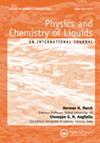Musk ketone solubility in binary systems ethyl acetate with methanol, ethanol, and isopropanol: preferential solvation according to the inverse Kirkwood–Buff integrals method
IF 1.2
4区 化学
Q4 CHEMISTRY, PHYSICAL
引用次数: 0
Abstract
ABSTRACTThree co-solvent mixtures {methanol (1) + ethyl acetate (2), ethanol (1) + ethyl acetate (2), and isopropanol (1) + ethyl acetate} were used to calculate the preferred solvation parameters (δx1,3) of musk ketone (MK) (2). In all co-solvent mixes, δx1,3 values vary non-linearly with the percentage of co-solvent (1). According to the study, δx1,3values are negative in mixes rich in alcohol but positive in those high in ethyl acetate. The mixtures {methanol (1) + ethyl acetate (2)} and {ethanol (1) + ethyl acetate (2)} show the most favoured solvation of MK by ethyl acetate at 298.15 K and 293.15 K, respectively. When {isopropanol (1) + ethyl acetate (2)} is combined; it is maximum at 298.15 K. Since the δx1,3 values are positive, MK preferentially solvates with ethyl acetate. The most significant values for x1 = 0.18–0.40 are obtained towards the non-polar regions of MK for the three co-solvent mixes.KEYWORDS: Musk ketoneco-solvent + ethyl acetate mixturesinverse Kirkwood–Buff integrals (IKBI)preferential salvation AcknowledgmentsThe authors extend their appreciation to the Deputyship of Scientific Research at Northern Border University, Arar, KSA for funding this research work through the project number “NBU-FFR-2023-0085.ˮDisclosure statementNo potential conflict of interest was reported by the authors.Supplementary materialSupplemental data for this article can be accessed online at https://doi.org/10.1080/00319104.2023.2275319Additional informationFundingThe work was supported by the Deputyship of Scientific Research at Northern Border University [NBU-FFR-2023-0085].麝香酮在乙酸乙酯与甲醇、乙醇和异丙醇二元体系中的溶解度:根据逆Kirkwood-Buff积分法优选溶剂化
摘要采用甲醇(1)+乙酸乙酯(2)、乙醇(1)+乙酸乙酯(2)和异丙醇(1)+乙酸乙酯)3种共溶剂混合物,计算麝香酮(MK)(2)的首选溶剂化参数δx1,3。在所有共溶剂混合物中,δx1,3值随共溶剂含量(1)的变化呈非线性变化。研究表明,δx1,3值在乙醇含量高的混合物中为负,在乙酸乙酯含量高的混合物中为正。在298.15 K和293.15 K下,{甲醇(1)+乙酸乙酯(2)}和{乙醇(1)+乙酸乙酯(2)}的溶剂化效果最好。当{异丙醇(1)+乙酸乙酯(2)}结合时;在298.15 K时达到最大值。由于δx1,3值为正,MK优先与乙酸乙酯溶剂化。对于三种共溶剂混合物,在MK的非极性区,x1 = 0.18-0.40的值最为显著。关键词:麝香酮生态溶剂+乙酸乙酯混合物逆Kirkwood-Buff积分(IKBI)优先拯救致谢致谢致谢致谢致谢致谢致谢致谢致谢致谢致谢致谢致谢致谢致谢致谢致谢致谢致谢致谢致谢致谢公开声明作者未报告潜在的利益冲突。本文的补充资料可在线访问https://doi.org/10.1080/00319104.2023.2275319Additional information。本研究得到了北方边境大学科学研究副主任[NBU-FFR-2023-0085]的支持。
本文章由计算机程序翻译,如有差异,请以英文原文为准。
求助全文
约1分钟内获得全文
求助全文
来源期刊

Physics and Chemistry of Liquids
化学-物理:凝聚态物理
CiteScore
3.30
自引率
8.30%
发文量
43
审稿时长
6-12 weeks
期刊介绍:
Physics and Chemistry of Liquids publishes experimental and theoretical papers, letters and reviews aimed at furthering the understanding of the liquid state. The coverage embraces the whole spectrum of liquids, from simple monatomic liquids and their mixtures, through charged liquids (e.g. ionic melts, liquid metals and their alloys, ions in aqueous solution, and metal-electrolyte systems) to molecular liquids of all kinds. It also covers quantum fluids and superfluids, such as Fermi and non-Fermi liquids, superconductors, Bose-Einstein condensates, correlated electron or spin assemblies.
By publishing papers on physical aspects of the liquid state as well as those with a mainly chemical focus, Physics and Chemistry of Liquids provides a medium for the publication of interdisciplinary papers on liquids serving its broad international readership of physicists and chemists.
 求助内容:
求助内容: 应助结果提醒方式:
应助结果提醒方式:


